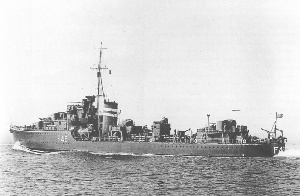HMS Juno (F46)
 HMS Juno (F46) | |
| History | |
|---|---|
| Name: | HMS Juno |
| Builder: | Fairfield Shipbuilding and Engineering Company |
| Laid down: | 5 October 1937 |
| Launched: | 8 December 1938 |
| Commissioned: | 25 August 1939 |
| Identification: | Pennant number: F46 |
| Fate: | Sunk by Italian aircraft, 21 May 1941 |
| General characteristics (as built) | |
| Class and type: | J-class destroyer |
| Displacement: |
|
| Length: | 356 ft 6 in (108.66 m) o/a |
| Beam: | 35 ft 9 in (10.90 m) |
| Draught: | 12 ft 6 in (3.81 m) (deep) |
| Installed power: |
|
| Propulsion: | 2 × shafts; 2 × geared steam turbines |
| Speed: | 36 knots (67 km/h; 41 mph) |
| Range: | 5,500 nmi (10,200 km; 6,300 mi) at 15 knots (28 km/h; 17 mph) |
| Complement: | 183 (218 for flotilla leaders) |
| Sensors and processing systems: | ASDIC |
| Armament: |
|
HMS Juno was a J-class destroyer of the Royal Navy laid down by the Fairfield Shipbuilding and Engineering Company, Limited, at Govan in Scotland on 5 October 1937, launched on 8 December 1938 and commissioned on 25 August 1939. Juno participated in the Battle of Calabria[1] in July 1940 and the Battle of Cape Matapan in March 1941.
Attacked and sunk
Juno was attacked by an Italian CANT Z.1007 aircraft from 50th group, flown by Lt. Mario Morassutti,[2] as she steamed with the Mediterranean Fleet against the German sea-borne invasion of Crete and sank 30 nautical miles south-east of Crete on 21 May 1941.[2]
At the time of her attack and sinking Juno was commanded by Cdr. St. John Reginald Joseph Tyrwhitt and would have had a complement of 183 to 218 seamen and officers. It is figured that 116 crew lost their lives after 3 high-powered explosions split Juno in two, sinking her in around 97 seconds.[3]
Notes
^ ab "HMS Juno (F 46) Destroyer of the J class". uboat.net. Retrieved 16 September 2012.
^ "HMS Juno (F46) [+1941]". www.wrecksite.eu. Retrieved 16 September 2012.
References
Colledge, J. J.; Warlow, Ben (2006) [1969]. Ships of the Royal Navy: The Complete Record of all Fighting Ships of the Royal Navy (Rev. ed.). London: Chatham Publishing. ISBN 978-1-86176-281-8. OCLC 67375475.
English, John (2001). Afridi to Nizam: British Fleet Destroyers 1937–43. Gravesend, Kent: World Ship Society. ISBN 0-905617-64-9.
Friedman, Norman (2006). British Destroyers & Frigates: The Second World War and After. Annapolis, Maryland: Naval Institute Press. ISBN 1-86176-137-6.
Hodges, Peter; Friedman, Norman (1979). Destroyer Weapons of World War 2. Greenwich: Conway Maritime Press. ISBN 978-0-85177-137-3.
Langtree, Charles (2002). The Kelly's: British J, K, and N Class Destroyers of World War II. Annapolis, Maryland: Naval Institute Press. ISBN 1-55750-422-9.
Lenton, H. T. (1998). British & Empire Warships of the Second World War. Annapolis, Maryland: Naval Institute Press. ISBN 1-55750-048-7.
March, Edgar J. (1966). British Destroyers: A History of Development, 1892–1953; Drawn by Admiralty Permission From Official Records & Returns, Ships' Covers & Building Plans. London: Seeley Service. OCLC 164893555.
Rohwer, Jürgen (2005). Chronology of the War at Sea 1939–1945: The Naval History of World War Two (Third Revised ed.). Annapolis, Maryland: Naval Institute Press. ISBN 1-59114-119-2.
Whitley, M. J. (2000). Destroyers of World War Two: An Illustrated Encyclopedia. London: Cassell & Co. ISBN 1-85409-521-8.
Winser, John de D (1999). B.E.F. Ships Before, At and After Dunkirk. Gravesend: World Ship Society. ISBN 0-905617-91-6.
Coordinates: 34°35′N 26°34′E / 34.583°N 26.567°E / 34.583; 26.567
This article about a specific destroyer of the United Kingdom is a stub. You can help Wikipedia by expanding it. |
